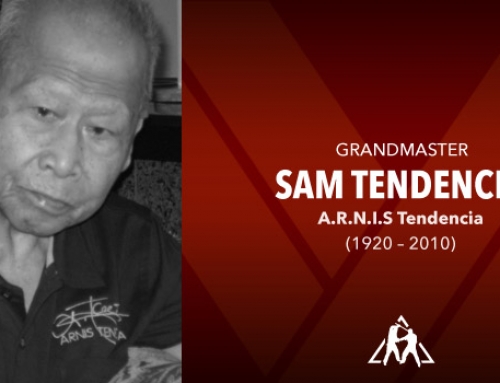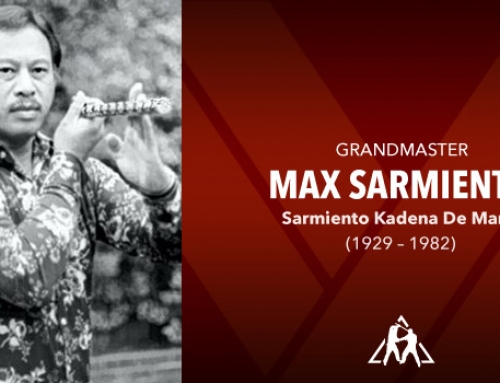According to old traditional Filipino custom, an eskrimador had to “prove” his ability over the years to be respected as a master of the Filipino art of eskrima or arnis. Inting Carin is such a master he’s respected throughout the Visayas especially the cradle of eskrima Cebu.
Carin proved his ability during the golden era of eskrima (1920-1960), a period when challenges were fought without the aid of armour and often resulted in serious injuries. After cheating death on many occasions, Carin continues to practice and teach his method of eskrima. He is one of the living legends of the Filipino martial arts. This is his story…
Joining the Guerrillas
Inting Carin began his tutelage in eskrima at the age of 16 under his Uncle Ponsing Ybanez, learning a variety of styles, which utilized the kampilan (sword) and the garote (stick).
He continued to train with his uncle until the outbreak of World War II, at which time he joined the Cebu guerrilla movement to fight against the Japanese invaders.
During this period Carin started developing a reputation as a combative eskrimador. World War II took the lives of many celebrated eskrimadors such as Doring Saavedra.
Carin was fortunate not be one of the casualties. After the war, seeking to improve his proficiency in the art, Carin studied with the late grandmaster Filemon “Momoy” Canete.
Carin observed the movements of the late Canete and modified his methods of espada y daga (sword and dagger), knifefighting (baraw), and combat judo (pangamut) to make them more practical and combative.
Carin’s exceptional ability was soon recognized by Momoy Canete and he was promoted to the rank of grandmaster within the famed doce pares organization.
During the early 1950s, the Doce Pares club was experiencing a difficult period. Personal differences forced one of its original members, Venancio “Ansiong” Bacon, to separate and form his own system balintawak arnis.
With this departure many leading eskrimadors also decided to leave doce pares and follow the venerated Bacon. Among these was the expert knifefighter Jesus Cui.
Line In The Sand
Line in the Sand An intense rivalry soon developed between the remaining members of the doce pares and the balintawak groups and challenge fights known as “juego todo” (no-holds-barred) were arranged.
Carin represented the doce pares and along with Cacoy Canete, faced the leading balintawak exponents, such as Delfin Lopez. He remained undefeated after many fights, which served as a tribute to his proficiency in eskrima.
Carin recalls an incident in 1955. “Me and some other doce pares teachers were invited to Talisay for food and drinks by a local eskrimador called Loro Larawan. Upon arrival, I was surprised to see so many people they turned out to be eskrimadors from that area. Larawan announced that there would be a comparison of styles.
It was a polite way of suggesting a challenge match. I accepted. Upon the handshake, my opponent whispered Inting, please no hard strikes to the head. “However, when we squared off, he did just the opposite! I deflected the potentially lethal strike to my head and countered with my retirada.
My opponent went down from a counterstrike to the head. I was going to finish him off, but Momoy Canete jumped in between us and stopped me from delivering further strikes.”
Prison Reform
Two other notable incidents occurred while Carin was serving time in Muntinlupa prison. He was sent “inside” for shooting Delfin Lopez. The first incident involved Federico Palma, a notorious criminal whom Carin a member of the Cebu Police Department at the time had imprisoned on murder charges.
“I was playing basketball one morning in the jail yard, when I felt something hit me in the ribs,” Carin remembers. “I turned around and was shocked to see Palma.
He was holding a two-by-two piece of wood, with which he tried to hit me again. I made an outside defense and got him in a necklock. His followers tried to attack me, but I used Palma as a shield. When the provincial guards arrived, I let him go. He was very black in the face.”
The other incident involved the captain of the guards, who was an eskrimador. Somehow, he was informed that Carin was also a noted eskrimador. He called Carin to his office and gave him a stick, after which he said, “Defend yourself.”
Carin defended but refused to strike back; otherwise he would probably not have made it out of prison alive. His only option was to disarm the captain.
This only enraged the captain, but the same thing happened again. In the end, Carin disarmed the captain four times. This assured the captain of Carin’s skill and he conveyed his admiration by asking Carin to teach him.
“Way of the Warrior”
Carin has had to apply his self-defense skills on numerous occasions in day-to-day life. The following incident was documented on the BBC’s “Way of the Warrior” episode on eskrima.
While attending a fiesta in the Mabolo district of Cebu, Carin noticed that a friend was being overrun by four men. After noticing one of the men drawing a knife and then preparing to stab his friend from behind, Carin instinctively parried the knife thrust and followed up with a kick to throw the attacker off balance.
Carin’s intervention forced the attackers to concentrate their energy on him. The mass attack was fast and furious; subsequently, Carin did not know how many he was facing.
Suddenly, Inting was smashed on the skull with a wooden chair, which sent him to the floor. As he lay on the ground bleeding profusely, one of the attackers sat on top of him and delivered finishing knife thrusts.
Carin was stabbed twice in the abdomen and received two extremely deep wounds. He finally disarmed his assailant and countered with a fatal thrust into the armpit of his attacker.
Left For Dead
At this point the police arrived. After turning over his knife to the lawmen, Carin collapsed and lost consciousness. One of the attackers lay dead and two others were seriously injured. Carin was presumed dead and together with the other casualties was taken to the funeral parlor.
Because of sheer luck or perhaps fate, the late grandmaster Eulogio “Yoling” Canete passed by the funeral parlor and was informed that Carin was one of the casualties. Canete realized that Carin still had signs of life and immediately rushed him to the hospital. It was later learned that the assailants numbered seven four brothers and three companions!
Today, Carin is thankful to God and his teachers; had it not been for his knowledge in eskrima, he says he would be ten feet under. The aforementioned incident and many others occurred decades ago, during a period when the Filipino arts were unknown outside of their native land.
Over the past decade, when the Philippines host “World Championships”, Carin is always present as an honorary guest. He usually watches the events with grandmaster Abner Pasa. “In the armour it’s a game, in the street it’s for real sports eskrima is useful to promote the art but don’t confuse or mistake it for the real art,” Carin insists.
Carin’s method of eskrima is recognized for its effectiveness a combination of simplistic movement and organization of technique. The following is a progressive list of what he teaches.
- Avercenario – 12 angles of attack.
- Bosyonario – Also known as the labangon stroke, which is based on the “X” pattern.
- Largada – Long range (larga mano) style.
- Herada – Aggressive attacking style of fighting.
- Retirada – Fighting while retreating.
- Corto – Close-range stickfighting.
- Sombra or Songkiti – A style specializing in thrusts.
- Depensa Todo – Meaning total defense, which emphasizes the use of: The “Live” Hand.
- Espada y daga – Combative application.
- Disarma – Stick disarming.
- Baraw defense – Utilizing disarms, locks and throws (also referred to as combat judo).
Grandmaster Vicente “Inting” Carin was among the last in a dying breed of Filipino stylist who has experienced some of the greatest training from some of the greatest masters.
It is recommended that anyone visiting the Philippines should experience his unique approach to teaching the Filipino arts.
***Published in Filipino Martial Arts Magazine, August 2001 and Budo International Magazine, May 2002 – By Krishna Godhania***






















Leave A Comment
You must be logged in to post a comment.